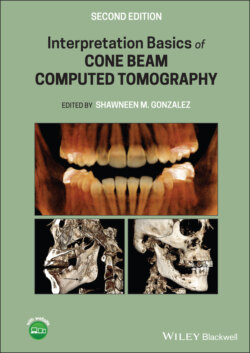Читать книгу Interpretation Basics of Cone Beam Computed Tomography - Группа авторов - Страница 26
Specific Orthodontic Uses
ОглавлениеIn 2015, Fisher recommended a list of case types for CBCT imaging in orthodontics.
1 = Impacted canines.
The most commonly impacted teeth are third molars and maxillary canines. CBCT imaging provides exact locations of impacted canines and the presence or absence of external root resorption of adjacent teeth (Figures 2.11 and 2.12). Cross‐sectional views are recommended to determine exact facial‐lingual width and effect on adjacent teeth. The FOV recommended is large enough to capture the tooth or teeth in question and surrounding bone and anatomical structures. The recommended voxel size is 0.3 mm to reduce the overall radiation exposure.
Figure 2.11. Reconstructed pantomograph and cross‐sectional slices showing location of an impacted maxillary canine (white arrow).
Figure 2.12. Cross‐sectional slices of an impacted maxillary canine with external resorption on the lingual aspect of the lateral incisor (white arrow).
2 = Orthognavthic surgery.
CBCT imaging has shown limited research that scans are reliable when determining the bony dimensions of a cleft palate (Figure 2.13). Cleft palate cases are recommended for CBCT imaging, as 2D radiographs cannot show facial‐lingual dimensions of a defect. This additional information is helpful to a surgeon especially prior to bone grafting and helpful to an orthodontist prior to movement of teeth near the defect. Axial views are recommended to determine the bone quantity surrounding roots of teeth adjacent to the cleft. The FOV recommended is large enough to see the entire cleft and portions of the nasal cavity for the surgeon to have all of the information necessary. The recommended voxel size is 0.3 mm or larger, so as to reduce the overall radiation exposure.
Figure 2.13. (a) Axial view showing a bilateral cleft palate (white arrows). (b) Coronal view showing a discontinuity of the floor of the right nasal cavity associated with a cleft palate (white arrow).
3 = Any patient needing anterior teeth moved in the sagittal plane.
4 = Temporary anchorage devices.
5 = Maxillary expansion.
6 = Permanent implant (see Chapter 11 for more information).
7 = Compromised airway.
8 = Temporomandibular joint disorder (TMD) (see Chapter 10 for more information).
9 = Supernumerary teeth (Figure 2.14).
Figure 2.14. (a) Cross‐sectional slices showing a supernumerary tooth position (white arrow) in relation to the erupted maxillary incisors. (b) 3D reconstruction showing a supernumerary tooth horizontally positioned.
10 = Pathology.
There are various bony lesions that present throughout the jaws (Figures 2.15 and 2.16). CBCT imaging provides additional information about the exact location and possible nature of a bony lesion prior to removal or biopsy. All views (axial, coronal, sagittal, and cross‐sectional) are recommended to completely grasp the size, position, and nature of a lesion. The FOV recommended is one large enough to capture the area in question. The recommended voxel size is 0.3 mm to reduce the overall radiation exposure.
Figure 2.15. (a) Periapical radiographs showing a well‐defined, corticated radiolucent area inferior to the apices of the mandibular incisors confirmed as an odontogenic myxoma histopathologically. (b) Pantomograph showing a well‐defined radiolucent area in the anterior mandible (white arrows) confirmed as an odontogenic myxoma histopathologically.
Figure 2.16. (a) Bitewing radiographs showing bone loss (white arrow) in the mandible. (b) Pantomograph showing a well‐defined, corticated, ovoid radiolucent area around an impacted mandibular right third molar (white arrow) consistent with a dentigerous cyst.
